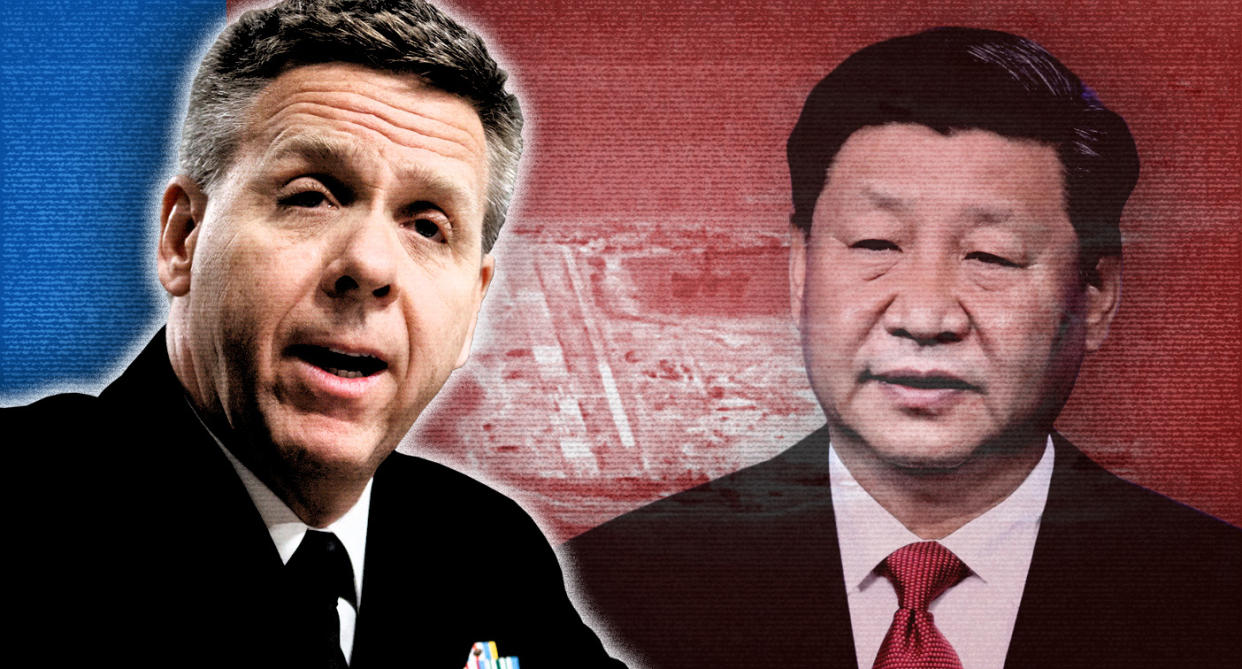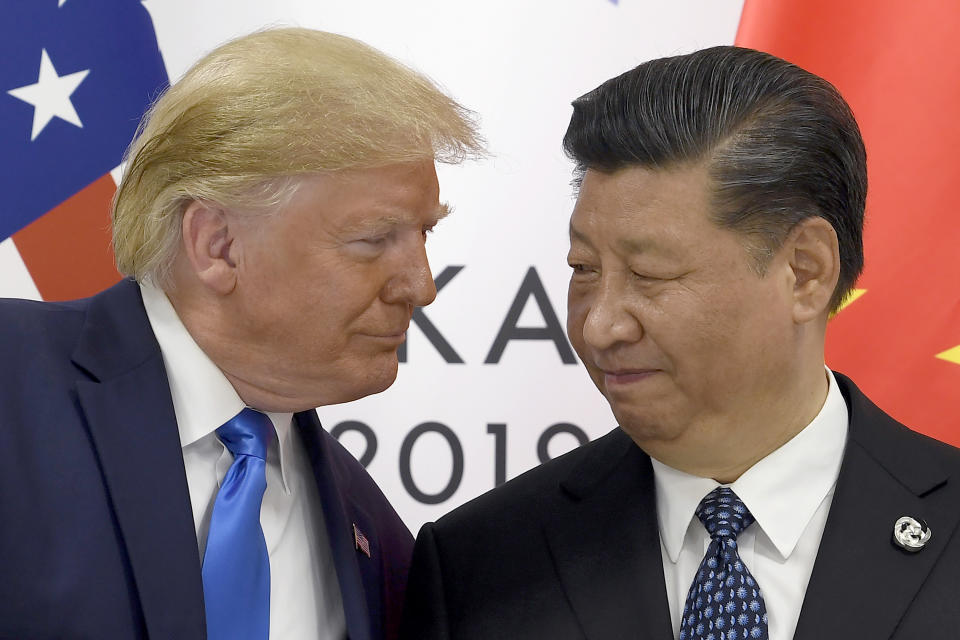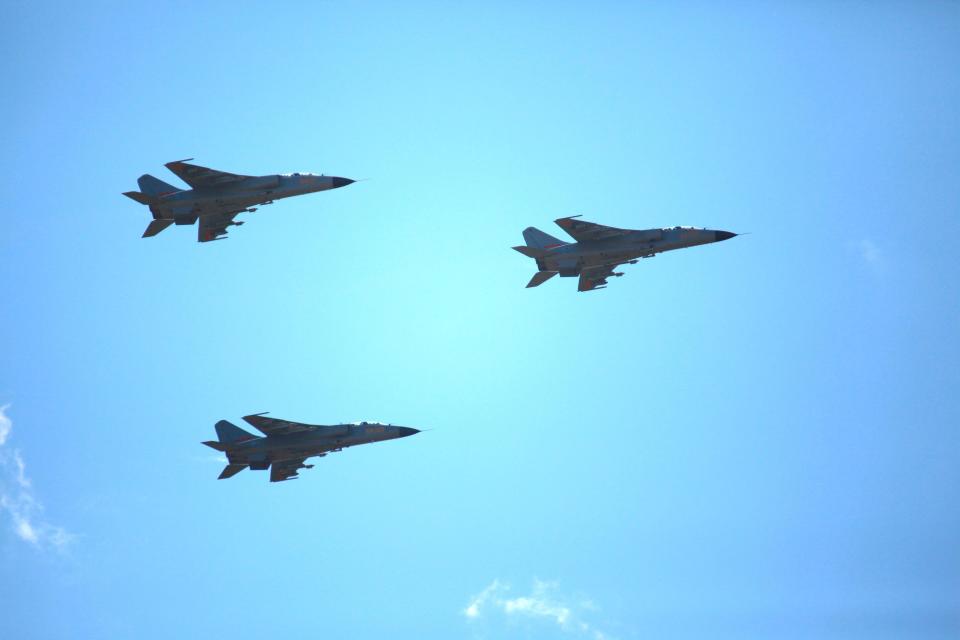China's bid for Asian domination: The view from U.S. Indo-Pacific Command

HONOLULU — The waters of Pearl Harbor above the USS Arizona have an oily sheen, the result of persistent leakage from the once mighty battleship that was sunk by Japanese bombs nearly 80 years ago. Locals refer to the area as “Black Tears,” in memory of the 1,102 American sailors and Marines still entombed in the wreckage below. The memorial that sits above the ship commemorates the events of Dec. 7, 1941, that began with a Japanese surprise attack and led directly to the U.S. entry into World War II.
The USS Arizona Memorial is a place for quiet contemplation, and at Pearl Harbor it is nearly impossible not to reflect on the dangers that gather when rising powers like 1930s-era Japan and Germany confront dominant or status quo powers like Great Britain and its American allies. In 12 of the 16 cases throughout history where that dynamic came into play, the end result was war.
In his expansive office on a hillside high above Pearl Harbor, Adm. Philip Davidson, head of U.S. Indo-Pacific Command, spends much of his time contemplating the increasing assertiveness of another rising power in Asia. His office displays a large, scale model of Fiery Cross Reef, one of seven artificial islands built on shallow reefs that China has constructed in international waters in the South China Sea. At the time of their construction in 2015, Chinese President Xi Jinping publicly promised not to militarize the manmade islands. As the model in Adm. Davidson’s office makes clear, however, Fiery Cross bristles with military facilities, which now include an airstrip, a protective harbor large enough to accommodate an aircraft carrier and anti-ship and surface-to-air missiles.

“I think we have to take the Chinese leadership at face value,” Davidson told me, noting that Beijing uses a “nine-dash line” as a border not recognized by international law to designate its dominion over the entire region, including a number of island chains contested by their Asian neighbors. “They claim the South China Sea as their sovereign territory, and the artificial islands are their attempt to defend that territory.”
By dropping the mask of accommodation and so quickly revealing the true motivation behind the island-building, the Chinese leader has focused the attention of Indo-Pacific Command and U.S. allies in Asia as never before. As the top U.S. military officer with responsibility for a vast region that stretches from the Indian subcontinent to the west coast of California, and encompasses roughly half of the earth’s surface (or from “Bollywood to Hollywood” as officials here say), Adm. Davidson is viewed by allies as the chief protector of the rules-based order that arose in Asia after World War II. What he and many allied leaders in the region see today is a Chinese economic, military and diplomatic juggernaut openly intent on achieving a dominant position in Asia in a matter of just a few years, and replacing the United States as the preeminent global power by mid-century. In the process, Beijing is attempting to recast the U.S.-led liberal international order into one that is more accommodating to China’s model of authoritarianism and mercantilist capitalism. The global stakes in this ideological competition have not been this high since the end of the Cold War.
“I disagree with the use of the phrase ‘New Cold War’ when discussing the Chinese challenge, because our approach and desire is not to try and ‘contain’ China like we contained the Soviet Union,” Davidson said. “We welcome China’s participation in a rules-based international order, and remind Beijing frequently of the prosperity that order has created, liberating hundreds of millions of people and literally lifting billions of people out of poverty. Having said that, the international order is now under assault by China and various other international actors, and we can’t ignore that. Because the United States and China have a fundamental divergence of values in terms of how we approach the current international order.”
That divergence in values is evident not only in China’s militarization of manmade islands in the South China Sea in defiance of international tribunals, he noted, but also in the predatory economic policies behind China’s “One Belt, One Road” initiative, which ignores World Trade Organization rules on transparency and entices poorer countries into a debt trap.

“You can also see that divergence of values in how China is treating Muslim Uighurs in western China (by interning them in “reeducation” camps), and in the recent democracy protests by the people of Hong Kong,” said Davidson. “All of that evidence suggests that China is looking to supplant the rules-based international order with one with Chinese characteristics that favors authoritarianism, which has a very chilling effect on the rest of the world. So that does represent a fundamental divergence in our vision of a free and open international order.”
For decades the United States followed a strategy of integrating China into the rules-based international order. Increased economic prosperity, including a nine-fold increase in China’s gross domestic product (GDP) since it joined the World Trade Organization in 2001, was supposed to moderate the Communist Party’s authoritarian doctrine and mercantilist policies which seek to maximize favorable trade imbalances through protectionism. Instead, China has continued to bend the rules of international trade, erecting steep tariffs, forcing foreign corporations to surrender intellectual property in order to access the Chinese market, and stealing U.S. technology through a persistent cyber-espionage campaign.
In 2015, Beijing went so far as to release a “Made in China 2025” 10-year plan to use government subsidies, state-controlled firms and “military-civil” fusion between the armed forces and private companies to pursue dominance in high-tech sectors from electric cars and artificial intelligence to robotics and next-generation information technology. In 2017, China went further by passing a National Intelligence Law, which requires that Chinese corporations, organizations and individuals support and assist its state intelligence services when asked, casting suspicion on the activities of Chinese global corporations such as the tech giant Huawei.
Exposure to Western values and global economic norms also did not prevent President Xi from centralizing power at home, extending his term in office and smothering domestic dissent with the world’s most intrusive surveillance state. China is now aggressively exporting the tools of that surveillance state to other authoritarian regimes. In an alarming echo of the Cultural Revolution, his government has also imprisoned a reported 1 million Muslim Uighurs in so-called reeducation camps.
“The old strategy presuming that China would liberalize as it was integrated more closely into the rules-based international order has simply not worked,” said Davidson. “The expected liberalization hasn’t occurred.”
In his testimony last week during Senate confirmation hearings, Chairman of the Joint Chiefs of Staff nominee Gen. Mark Milley warned that China will be the United States’ chief military rival for the next “50 to 100” years, and noted that the Chinese military is modernizing “very, very rapidly — in space, air, cyber, maritime and land domains.”

As the U.S. military command at the forefront of that rivalry, Indo-Pacific Command has charted China’s military modernization in alarming detail. Today, China has the most active and diverse ballistic missile development program in the world, complete with a new fleet of submarines. It also has the world’s largest navy at approximately 350 ships, augmented by the largest coast guard, and a “maritime militia” of fishing boats who answer to the Chinese navy and routinely harass ships in disputed areas of the South and East China Seas. The seven newly armed manmade islands are also clearly building blocks in China’s campaign to dominate its near seas, providing permanent forward basing for weapons that can threaten international ship and aircraft traffic. China’s number of fighter and bomber squadrons already far outnumber U.S. counterparts in the region.
In charts tracing those trends in Beijing’s military modernization, Indo-Pacific Command shows the People’s Liberation Army (PLA) reaching rough parity with U.S. forces in the Pacific in just the next few years, and then rapidly surpassing them. Last November, a congressionally mandated report by the U.S.-China Economic and Security Review Commission seconded that assessment, concluding that China’s military modernization means “the United States and its allies and partners can no longer assume achieving air superiority in an Indo-Pacific conflict.”
“What I would say about China’s military modernization is that it certainly appears out of proportion to the security threats China faces. There is no proportional threat to China that would seem to justify its very rapid military modernization,” said Adm. Davidson, noting that the status of U.S. forces in the Pacific has not increased markedly in this same time frame. “So in that sense, the trend line in China’s military modernization are worrisome.”

As was the case with the manmade islands, China has publicly insisted that its “One Belt, One Road” initiative funding scores of infrastructure projects around the world — from Asia to Africa to South America — is intended only as a vehicle for peaceful economic development. Indo-Pacific Command experts discern instead a classic “string of pearls” strategy, designed to painstakingly establish a globe-spanning logistics infrastructure to host Beijing’s burgeoning military forces. Earlier this month, China’s top defense official all but conceded the point, telling a gathering of military chiefs from the South Pacific and Caribbean nations of Beijing’s intent to militarize the Belt and Road initiative by using it as a framework for greater military cooperation.
Through its Belt and Road initiative, Indo-Pacific Command officers see a campaign by China to replicate the United States’ own globe-spanning military operations and network of alliances.
“I think it’s fair to say that China has gone to school on the ‘American way of war,’” said Davidson. “There is no doubt that the Chinese are watching our operations closely. You see that in the whole Chinese military portfolio, not only in terms of equipment modernization, but also in how they operate and the global structure of bases they are assembling. They are mimicking not just the U.S. Navy, but our entire joint military capability.”
The fundamental difference, he notes, is that the U.S. architecture of global alliances is built on a foundation of shared interests, in contrast to a Belt and Road initiative based on debt dependency. “When he talked about Belt and Road, [former Secretary of Defense Jim] Mattis used to refer to China’s idea of an alliance structure as consisting of ‘tribute states,’” said Davidson.
Certainly, as it has gained dominant economic and military power in Asia, China has become steadily more open and assertive — some would say provocative — in flexing its military muscles and touting its lofty ambitions. When the USS Decatur was conducting a routine freedom of navigation patrol in international waters near the Spratly Islands last October, for instance, a Chinese destroyer nearly collided with it. A Royal Navy warship on a recent patrol in the South China Sea reported similar harassment. Chinese bombers also routinely fly within missile launch range of Guam in what Indo-Pacific Command officials interpret as a not-too-subtle message. Last year, for the first time, Chinese air and ground forces trained side by side with their Russian counterparts in the Vostok 2018 military exercise.

During the Shangri-La Dialogue meeting of Asia’s top national security leaders in Singapore last month, Beijing sent another message to its neighbors by testing a new submarine-launched ballistic missile. Inside the auditorium of the Shangri-La Dialogue, Gen. Wei Fenghe, China’s defense minister, gave what many attendees interpreted as a bellicose and threatening speech.
Wei defended China’s militarization of the seven artificial islands in international waters in the South China Sea (“Chinese islands and reefs in the South China Sea are part of the Chinese territory … and other people come into our home all the time and threaten us. Why can we not develop some weapons to defend ourselves?”); characterized the imprisonment of 1 million Chinese Muslims as “vocational training” (local Chinese officials “have carried out a vocational-education and training center to ensure that there are no terrorist attacks, to help these people de-radicalize and help them learn some skills”); warned democratic Taiwan that it must and will be unified with the communist mainland (“If anyone dares to split Taiwan from China, the Chinese military has no choice but to fight at all costs for national unity”); and above all painted the United States as the international rogue and regional troublemaker (“What are the purposes for certain countries to send military vessels and aircraft all the way from afar to this region? Are there not enough examples that some big countries intervene in regional affairs, make trouble and then walk away and leave a mess behind?”).
In describing the threat posed by President Xi Jinping’s “China Dream” and long-range plan to become the dominant global power, Indo-Pacific Command officials use the analogy of a frog slowly succumbing without a fight in a vat of hot water as the heat is turned up gradually. With officials like Defense Minister Wei acknowledging China’s once concealed regional and global ambitions, the hope is that the United States and its allies will awaken to the danger before it’s too late.

“I’m trying to understand if China is letting down the mask based out of confidence, or hubris, because certainly the Chinese defense minister’s speech at the Shagari-La Dialogue was stunning,” said Davidson. “Basically he said that Asia is not for the Asians, but rather for the Chinese. Everyone who listened to that speech had that same takeaway. So yes, ever since Xi Jinping became president, I think China has become increasingly transparent and open about its ambitions.”
To rise to that challenge, Davidson noted that Indo-Pacific Command is receiving the Defense Department’s newest and most capable weapons systems, which will include “fifth-generation” stealth fighters like the F-22 and F-35, and it is planning to increase capabilities in terms of air and missile defense, cyber and space systems, and submarines. Close allies such as Japan and South Korea are also buying state-of-the-art U.S. weapons systems such as the F-35 and Aegis air defense system, and Australia is buying top-line U.S. combat systems for its submarines. The command is also forming closer partnerships with nontreaty allies in the region such as Singapore and Vietnam. A coalition of nations that include Japan, South Korea, New Zealand, France and Britain are also assisting Indo-Pacific Command forces in enforcing United Nations sanctions on North Korea over its nuclear weapons program.
“All of that activity speaks to the strength of our alliances and the military-to-military relationships in the region that support them,” said Davidson. “We’re showing the willingness of free peoples to take meaningful steps to defend the rules-based international order when it is threatened.”
James Kitfield is senior fellow at the Center for the Study of the Presidency & Congress, and author of “Twilight Warriors: The Soldiers, Spies and Special Agents Who Are Revolutionizing the American Way of War”
_____
Download the Yahoo News app to customize your experience.
Read more from Yahoo News:

